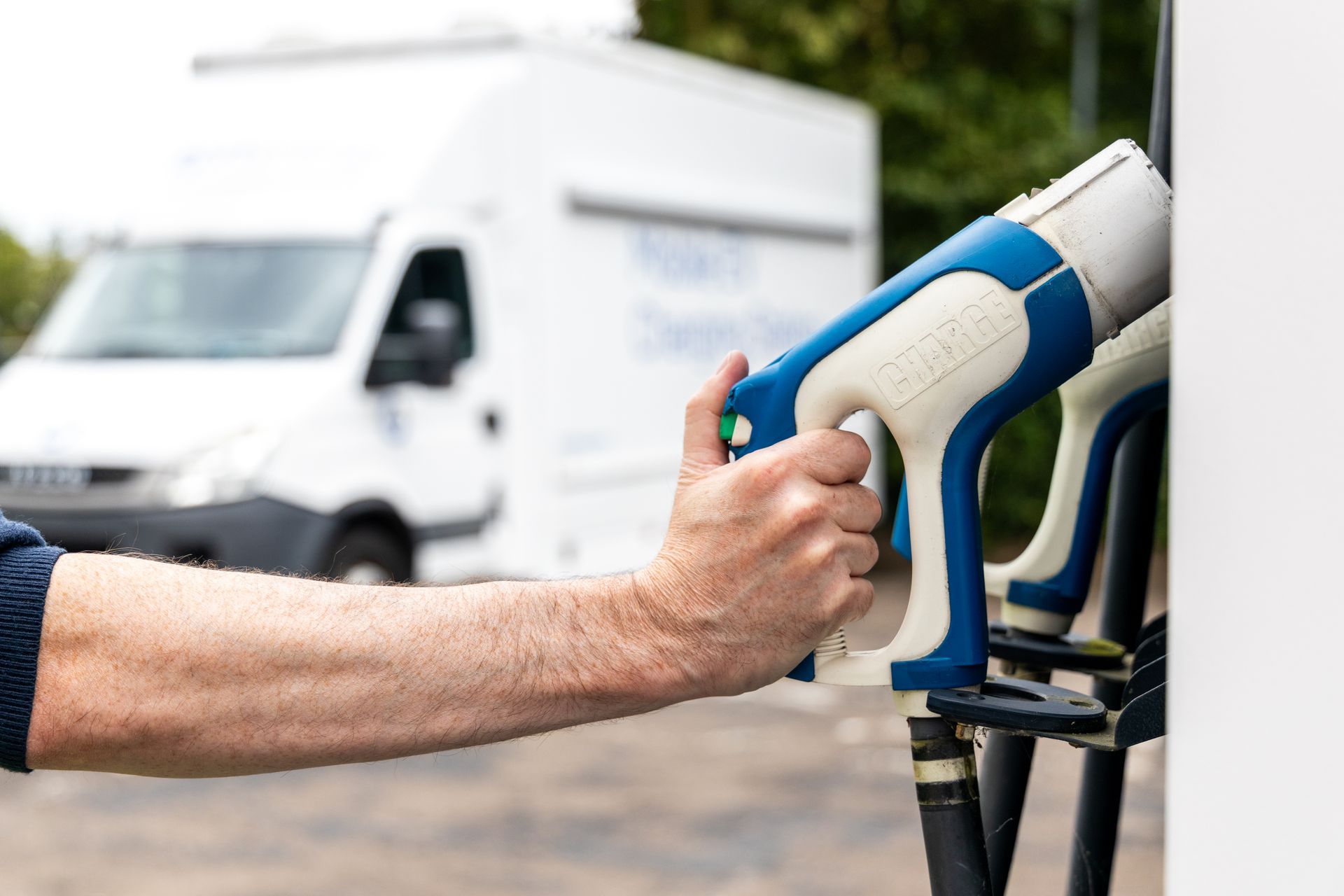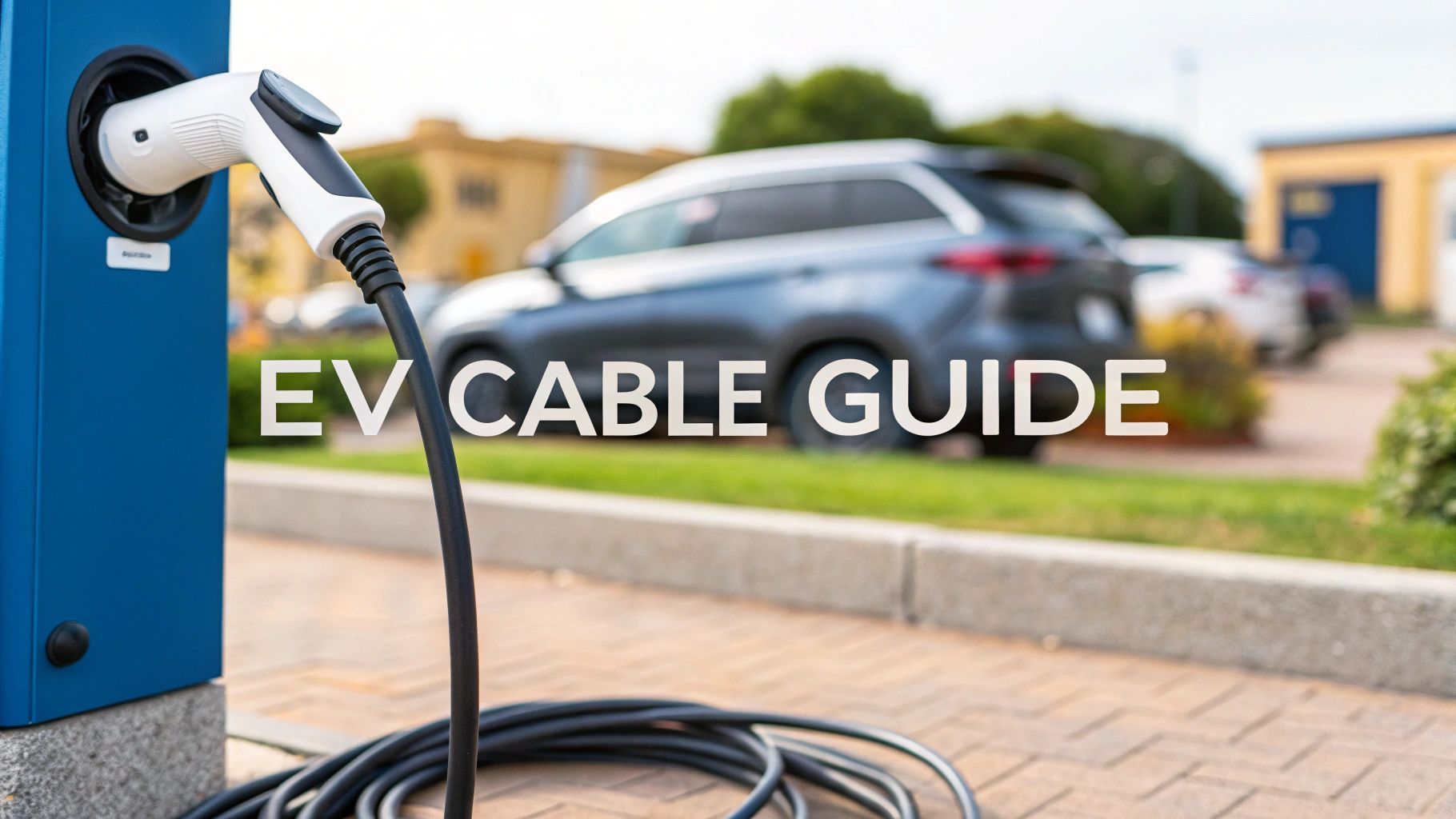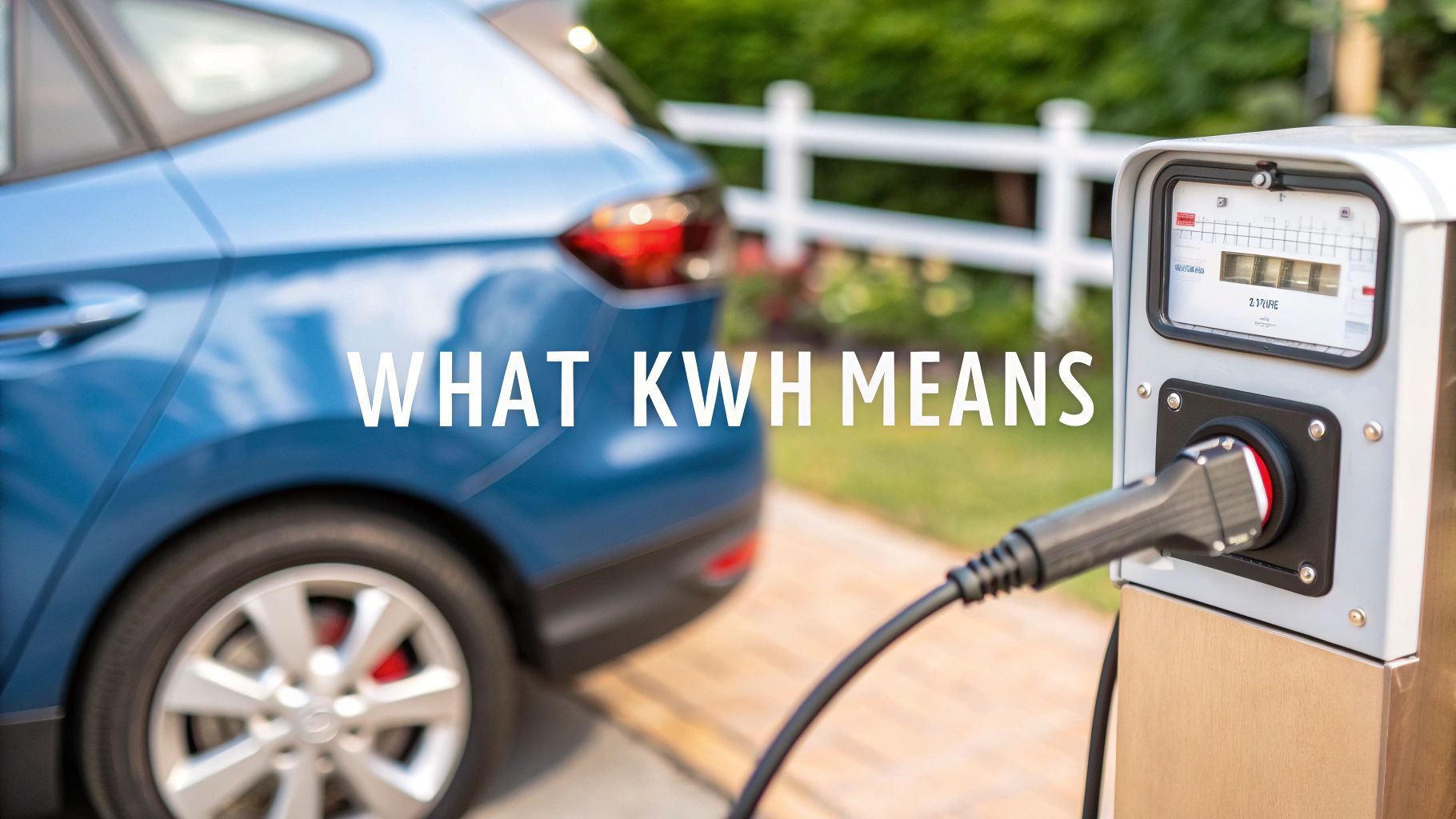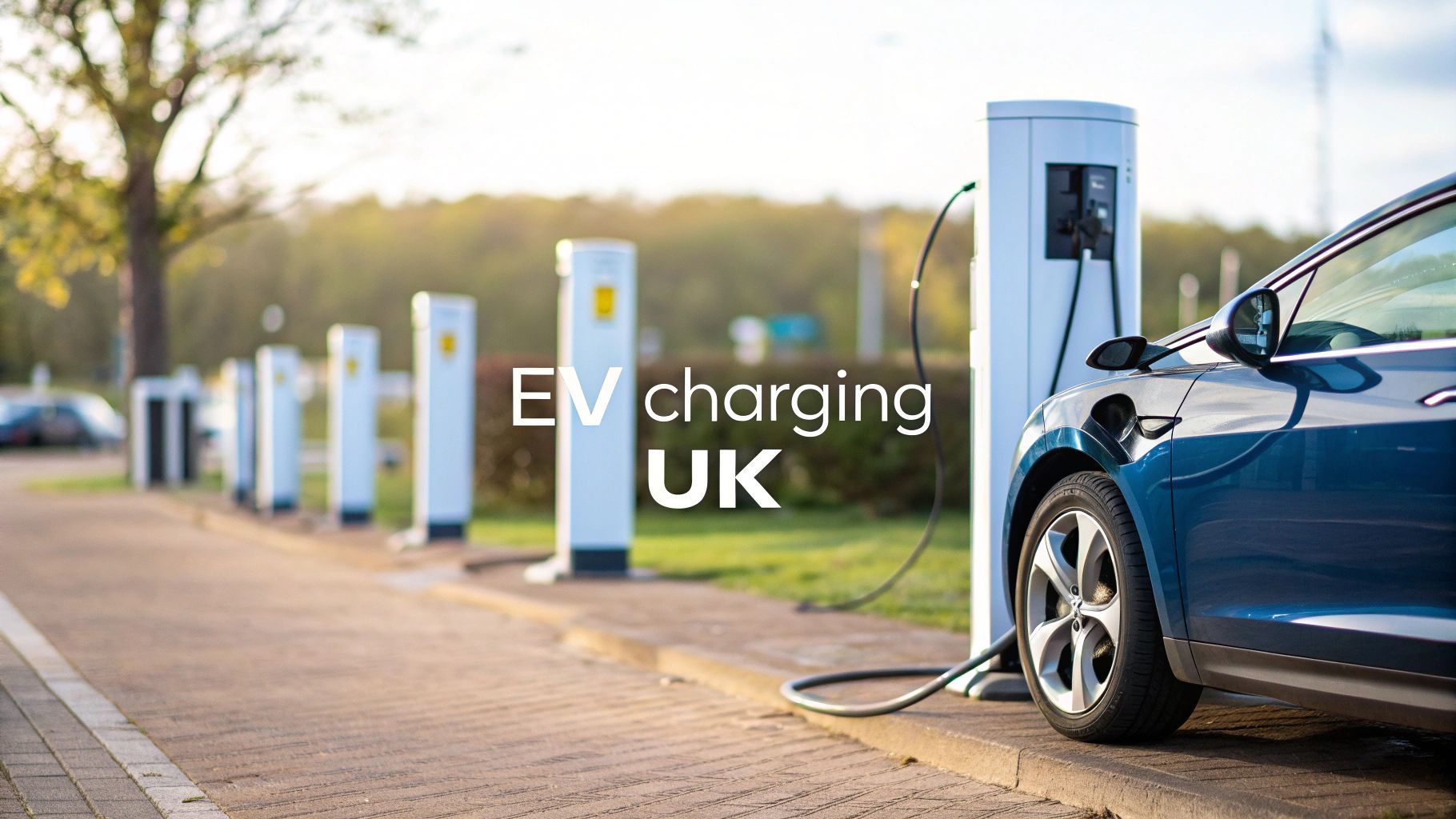Understand what is kilowatt hour and how it lowers bills
Ever glanced at your electricity bill and wondered what a kilowatt-hour actually is? It’s the standard unit your energy supplier uses to measure how much electricity you’ve used and it’s the key to understanding your monthly costs.
Think of it like this: a kilowatt-hour isn't a measure of speed but of volume. It’s the difference between measuring petrol in litres (the total amount you put in your tank) and the speed at which you pump it.
Demystifying the Kilowatt-Hour
When your energy bill arrives, that big number at the top is directly tied to the kilowatt-hours you've consumed. Getting your head around this single unit is the first step to properly managing your energy spend, whether you're boiling a kettle, running a business or charging an electric vehicle.
Let's break the term down into its three simple parts to see what it really means.
Kilo: One Thousand Units
First up, the prefix 'kilo'. This is a standard metric term that just means one thousand. It’s the same ‘kilo’ you find in a kilogram (one thousand grams) or a kilometre (one thousand metres).
So, a kilowatt is simply one thousand watts . This prefix helps scale the measurement up to a practical size for billing purposes.
Watt: The Rate of Power
Next, we have the 'watt'. A watt is a unit of power, measuring the rate at which energy is used at any single moment. You can think of it as the speed or flow of electricity.
A bright, 100-watt light bulb is using energy twice as fast as a dimmer 50-watt bulb. It has a higher demand for power right now.
The key distinction is that a watt measures the instantaneous demand for power, while a kilowatt-hour measures the total energy consumed over a period. This difference is crucial for understanding your energy bills.
Hour: The Element of Time
The final piece of the puzzle is 'hour', which brings in the dimension of time. This is what combines the rate of power (kilowatts) with duration (hours) to measure the total volume of energy you've actually used.
If you run a 1,000-watt (or 1 kW) appliance for one full hour, you've used exactly one kilowatt-hour of electricity. Simple as that.
To make this even clearer, here’s a quick breakdown.
Kilowatt-Hour (kWh) at a Glance
This simple table connects the dots between the components.
| Component | What It Means | Simple Analogy |
|---|---|---|
| Kilo | A prefix meaning 1,000. | Like a kilometre is 1,000 metres. |
| Watt | The rate of energy use (power). | The speed water flows from a tap. |
| Hour | The duration of energy use. | How long you leave the tap running. |
| kWh | The total volume of energy consumed. | The total amount of water collected in a bucket. |
This straightforward formula—power multiplied by time—is the foundation of every electricity bill you receive.
This is the standard unit used to measure electricity consumption across the UK. According to Ofgem’s Typical Domestic Consumption Values, the average UK household uses around 2,700 kWh of electricity annually. You can explore more about average UK electricity usage to see how your own consumption compares.
How to Calculate Your Appliance Energy Usage
Ever wondered which of your appliances is the real culprit behind your high electricity bill? Understanding what a kilowatt-hour is becomes truly powerful when you can apply it to your own home. By working out the energy usage of your devices, you can pinpoint exactly where your electricity is going and find the biggest opportunities to save.
The great thing is, you don’t need any fancy tools to get started. All it takes is a simple formula and a bit of information you can find on nearly every electrical device in your house.
The Simple Formula for kWh Consumption
Calculating your appliance’s energy use comes down to one straightforward equation. This is the very same method energy companies use to work out your bill, just on a much smaller scale.
The Formula: Appliance Power (in kilowatts) × Hours of Use = Kilowatt Hours (kWh) Consumed
To put this to work, you just need two key bits of information: how much power your appliance uses and how long you typically run it for.
Finding an Appliance's Wattage
Every electrical appliance has a label or sticker somewhere on it that lists its technical details. You’ll usually find this on the back or bottom of the device, or sometimes near the power cord. What you're looking for is a number followed by a "W" for watts .
If you can’t spot the sticker, the appliance's user manual is your next best bet. For larger appliances like ovens or washing machines, the power rating is often listed on the inside of the door.
Once you have the wattage, you need to convert it into kilowatts (kW) for the formula. Since 'kilo' means one thousand, the conversion is nice and easy:
- Divide the wattage by 1,000 to get kilowatts.
For instance, a 2,000-watt kettle is equal to 2 kW ( 2,000 ÷ 1,000 = 2 ). A 100-watt television is equal to 0.1 kW ( 100 ÷ 1,000 = 0.1 ).
Putting It All Together with Real Examples
Right, let's apply the formula to a few common household items and see how many kilowatt-hours they actually use.
-
Boiling a Kettle: A typical electric kettle might be rated at 3,000 watts (3 kW) . If it takes about 4 minutes (or 0.067 hours ) to boil a full kettle, the calculation is: 3 kW × 0.067 hours = 0.2 kWh .
-
Watching Television: Your modern 55-inch LED TV might use around 150 watts (0.15 kW) . If you settle in to watch it for three hours in the evening, the energy used would be: 0.15 kW × 3 hours = 0.45 kWh .
-
Using an Electric Oven: An electric oven is a much more power-hungry appliance, often rated around 2,500 watts (2.5 kW) . If you use it to bake something for one hour, its consumption is simply: 2.5 kW × 1 hour = 2.5 kWh .
By doing these quick sums, you can build a clear picture of your home’s energy profile. For those interested in the more technical side of accurately tracking electricity use, you can explore detailed methodologies for energy consumption measurement.
This hands-on approach takes the mystery out of your energy bill and puts you back in control. If you want to dive even deeper, you can learn more about how to calculate a kilowatt-hour and see which devices are the real energy hogs in your home.
What One Kilowatt-Hour Can Actually Power
Understanding the definition of a kilowatt-hour is one thing but seeing what it can do really brings the concept to life. A single kWh is more than just a number on your bill; it's a tangible amount of energy that powers your daily routines.
Getting a feel for this unit helps you develop a more intuitive sense of your household's electricity consumption. When you can connect the kWh to everyday appliances and activities, you start to see where the real energy usage lies. That knowledge is the first step toward making smarter choices that can lead to significant savings.
Visualising a Single kWh
To really grasp its value, let's look at what one kilowatt-hour can achieve in a typical UK home. It’s a surprisingly useful amount of energy.
A single kWh is enough to:
- Power a modern fridge for nearly a full day.
- Run a dishwasher for one complete cycle.
- Let you watch around 10 hours of television on an energy-efficient LED screen.
- Boil water in a 3kW kettle about 10 times —perfect for a day's worth of tea or coffee.
These examples show how a single unit of electricity is woven into the fabric of our daily lives, from keeping our food fresh to providing entertainment.
The following infographic illustrates the basic formula for calculating energy usage, showing how an appliance's wattage and the time it's used combine to determine its kWh consumption.

This visual reinforces that understanding kWh is simply a matter of knowing the power of your device and how long you run it for.
Appliance Energy Demands in Your Home
While some devices sip electricity gently, others are far more demanding. Knowing the difference is key to managing your home's energy footprint. Low-power items used for long periods can certainly add up but it's often the high-power appliances used in short bursts that make the biggest impact.
For instance, a typical fridge-freezer uses about 1 kWh over 26 hours , whereas a powerful electric oven can use around 2 kWh in just 30 minutes of baking. Meanwhile, energy-intensive appliances like tumble dryers can consume a substantial 4.5 kWh per cycle. These figures highlight where you can find the biggest opportunities for savings, as you can see by exploring more about household appliance energy usage on ecoflow.com.
The biggest consumers of energy are often those that generate heat. Appliances like ovens, tumble dryers, electric heaters and kettles require a significant amount of power to function, making them primary targets for mindful usage.
Comparing High-Drain vs Low-Drain Appliances
To put this all into perspective, let's compare some of the most and least power-hungry items you likely have at home. This table breaks down common appliances, their power ratings and their estimated monthly costs, giving you a clearer view of your energy landscape.
Appliance Energy Usage and Estimated Monthly Cost
| Appliance | Power Rating (Watts) | Hours Used Per Day | Monthly kWh Usage | Estimated Monthly Cost |
|---|---|---|---|---|
| Tumble Dryer | 2,500 W | 0.5 (used 15x/month) | 37.5 kWh | £10.13 |
| Electric Oven | 2,100 W | 1 | 63 kWh | £17.01 |
| Fridge-Freezer | 120 W | 8 (active time) | 28.8 kWh | £7.78 |
| LED Television | 100 W | 4 | 12 kWh | £3.24 |
| LED Light Bulb | 10 W | 6 | 1.8 kWh | £0.49 |
*Estimated costs are based on an average electricity price of 27p per kWh and are for illustrative purposes only.
This comparison makes it obvious: an hour of using the oven costs far more than several hours of watching TV. By understanding what a kilowatt-hour can power, you gain the ability to make informed decisions, swapping energy-hungry habits for more efficient ones and ultimately taking control of your electricity bills.
Kilowatt-Hours and the Rise of Mobile EV Charging
The shift to electric vehicles (EVs) is fundamentally changing how we think about energy. Charging an EV is one of the biggest power demands a household can have, often using more kilowatt-hours in one go than many appliances use in an entire day. This has created a significant business opportunity, particularly where fixed charging points are either unavailable or simply inconvenient. Suddenly, the humble kilowatt-hour is no longer just a cost on your utility bill; it’s a commodity that can be bought, transported and sold for a profit.
This is precisely where the business model for mobile EV charging excels. It is a wonderfully simple concept, founded on the timeless principle of supply and demand, with distinct advantages for both the operator and the customer.
The Business of Selling Kilowatt-Hours
At its core, a mobile EV charging business is a straightforward retail operation: you buy electricity at a standard rate per kWh and then sell it on at a premium. The operator essentially becomes a mobile energy retailer, delivering convenient power directly to an EV owner who needs it.
The profitability lies in the price margin. An operator might buy electricity from the grid for £0.25 per kWh but sell it for £0.60 per kWh or more as a mobile service. That markup covers the cost of the mobile charging unit, vehicle expenses and the operator's time, while still leaving a healthy profit margin.
The advantage of this model is that it sells convenience. For an EV driver stranded with a low battery, stuck at a workplace with no chargers or living in a flat without off-street parking, having a charge delivered is a valuable service worth paying for. It transforms a major inconvenience into a simple, on-demand solution.
How Charging Speeds Impact Revenue
Not all charging is created equal and the speed at which you can deliver those kilowatt-hours directly impacts how much money you can make. Mobile charging units come in various power outputs, which dictates how quickly you can top up an EV's battery.
- Level 2 Charging (7-22 kW) : These chargers offer a steady flow of energy, perfect for topping up a vehicle over a few hours at a workplace or in a residential area. An operator could easily service several cars in one location throughout the day.
- Rapid Charging (50 kW+) : These powerful units can add significant range in a short amount of time, making them ideal for emergency roadside assistance or for drivers on a tight schedule. They deliver more kWh faster, letting an operator serve more customers each day.
The faster the charge, the more kilowatt-hours are sold per hour. This means an operator with a rapid charger can generate revenue much more quickly than one with a slower unit, though the initial investment in the equipment will be higher.
A key decision for any mobile charging operator is finding the right balance between the cost of their equipment and the speed of service. A faster charger costs more upfront but enables a higher turnover of customers, maximising the number of kilowatt-hours sold in a working day.
This flexibility allows operators to tailor their services. Some might focus on providing slower, scheduled top-ups for office car parks, while others specialise in high-speed emergency call-outs. Understanding the distinction is key to spotting the best market opportunities. To explore this further, you can read our detailed comparison of stationary vs mobile EV charging solutions.
A Profitable Scenario Unpacked
Let's break down what the potential earnings could look like for a mobile charging operator. Imagine someone running a 50 kW rapid mobile charger.
- Cost of Energy : The operator charges their mobile power bank overnight at a cheap, off-peak rate of £0.15 per kWh.
- Service Call : A customer needs a 25 kWh top-up to get home. With a 50 kW charger, this takes about 30 minutes .
- Pricing : The operator charges the customer £0.65 per kWh, plus a small call-out fee. The total for the energy comes to 25 kWh × £0.65 = £16.25 .
- Profit Calculation : The operator's cost for that electricity was just 25 kWh × £0.15 = £3.75 . The gross profit on the energy alone is £12.50 for a half-hour job.
If this operator completes just six similar jobs in a day, they could generate over £75 in gross profit from the energy sold, and that’s before adding any call-out fees. It’s a clear demonstration of how kilowatt-hours can be transformed from a simple cost into a direct source of income.
Actionable Tips for Reducing Your kWh Consumption

Understanding what a kilowatt-hour is puts you in the driver's seat. The next step is using that knowledge to actively cut down your home's electricity consumption, which translates directly into smaller bills and a lighter environmental footprint.
The good news is that reducing your kWh usage doesn't demand a complete lifestyle overhaul. It often just comes down to a series of small, mindful adjustments that really add up.
Smart Lighting and Appliance Use
Your lights and everyday appliances are one of the easiest places to start. These devices steadily contribute to your daily kWh total, so getting smarter about how you use them can lead to quick and satisfying savings.
-
Switch to LED Bulbs: If you haven't already, this is a must. LED bulbs use up to 85% less energy than old-school incandescent bulbs to give you the same amount of light, drastically cutting the kWhs needed to light up your home.
-
Unplug 'Vampire' Devices: Many of your electronics are secretly drawing power even when they're switched off. This standby power, or 'phantom load', can be responsible for up to 10% of a household's annual electricity use. Get into the habit of unplugging chargers, televisions and games consoles, or use a smart power strip to cut them off completely.
-
Run Full Loads: Only put your dishwasher and washing machine on when they're completely full. These appliances use roughly the same amount of energy per cycle whether they're half-empty or packed, so you can slash your kWh consumption just by running them less often.
Optimising Your Heating and Cooling
Heating and cooling are two of the biggest energy hogs in any home. Even tiny tweaks here can lead to substantial savings on your kilowatt-hour usage over the course of a year.
It’s an interesting trend: while the UK's total electricity demand has been falling since 2005 , our domestic consumption has actually gone up, making homes the largest end-users. This really underlines how important home energy efficiency has become.
A simple trick can make a huge difference if you're on a variable rate tariff like Economy 7. Using appliances during off-peak hours—like running the washing machine or charging devices overnight when the price per kWh is lower—can directly shrink your monthly bill without changing how much energy you use.
Beyond just knowing what a kWh is, the real win comes from putting comprehensive strategies to reduce energy consumption in your home into practice.
Upgrades and Long-Term Strategies
While daily habits are important, investing in energy-efficient upgrades offers long-term, passive savings. These changes might require an initial outlay but they pay for themselves over time by consistently lowering your kWh consumption.
Think about upgrading older, power-hungry appliances like fridges and freezers to newer models with a high energy efficiency rating. An A-rated appliance uses far fewer kilowatt-hours over its lifespan than a D-rated one.
In the same way, improving your home's insulation and draught-proofing cuts down the energy needed to heat it—a massive contributor to your bill if you use electric heating. These kinds of improvements are fundamental to creating a more energy-efficient home. For businesses, adopting new approaches like Zapme's Energy as a Service model can also create significant efficiencies.
Got Questions About Kilowatt-Hours?
To wrap things up, let's tackle some of the most common questions people have about the kilowatt-hour. Think of this as a quick-fire round to clear up any lingering confusion and make sure you feel completely confident with the concept.
How Is a kWh Different from a kW?
This is easily the most common stumbling block but the difference is simple once you find the right analogy. A kilowatt (kW) measures power —the rate electricity is being used at any single moment. In contrast, a kilowatt-hour (kWh) measures the total energy consumed over time.
Picture yourself driving. The kilowatt (kW) is your speed right now, say, 60 miles per hour . The kilowatt-hour (kWh) is the total distance you’ve travelled, like the 60 miles you covered after driving for an hour. One is the immediate rate, the other is the total amount.
Why Does the Price per kWh Change on My Bill?
If you’ve ever looked closely at your bill, you might have noticed the cost of a single kilowatt-hour isn’t always the same. That’s because many UK energy suppliers use time-of-use tariffs to help manage demand on the national grid. Simply put, the price changes depending on the time of day.
These pricing structures usually break down into:
- Peak Hours: When demand is highest (often in the early evening as people get home from work), the price per kWh goes up.
- Off-Peak Hours: When demand is lower (typically overnight), the price per kWh is much cheaper.
A classic example is the Economy 7 tariff, which gives you seven hours of cheaper electricity overnight. This is perfect for running high-drain appliances like washing machines or charging an electric vehicle, letting you make some real savings on your bill.
Is My Electricity Meter Accurate?
Your electricity meter is the official record of your energy use in kilowatt-hours and it’s what your supplier relies on to calculate your bill. Here in the UK, all meters are tightly regulated and must be officially certified to ensure they’re accurate. For the most part, they are incredibly reliable.
Of course, faults can happen. If your bills suddenly shoot up but your habits haven't changed, you have the right to ask your supplier for a meter accuracy test. If it turns out the meter is faulty, they are required to replace it and sort out your bills.
Ready to turn your kilowatt-hour knowledge into a real-world advantage? ZAPME offers pioneering mobile EV charging that transforms the kWh into a business opportunity. Whether you're an EV driver needing a top-up or a fleet manager looking for a smarter solution, our mobile units deliver power exactly where it's needed. Discover our services and see how we're making energy more flexible.











